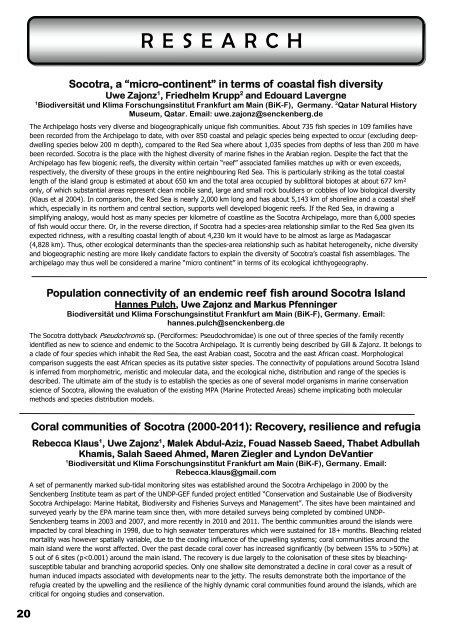TAYF the Soqotra Newsletter - Friends of Soqotra
TAYF the Soqotra Newsletter - Friends of Soqotra
TAYF the Soqotra Newsletter - Friends of Soqotra
Create successful ePaper yourself
Turn your PDF publications into a flip-book with our unique Google optimized e-Paper software.
20<br />
RESEARCH<br />
Socotra, a “micro-continent” in terms <strong>of</strong> coastal fish diversity<br />
Uwe Zajonz 1 , Friedhelm Krupp 2 and Edouard Lavergne<br />
1 Biodiversität und Klima Forschungsinstitut Frankfurt am Main (BiK-F), Germany. 2 Qatar Natural History<br />
Museum, Qatar. Email: uwe.zajonz@senckenberg.de<br />
The Archipelago hosts very diverse and biogeographically unique fish communities. About 735 fish species in 109 families have<br />
been recorded from <strong>the</strong> Archipelago to date, with over 850 coastal and pelagic species being expected to occur (excluding deepdwelling<br />
species below 200 m depth), compared to <strong>the</strong> Red Sea where about 1,035 species from depths <strong>of</strong> less than 200 m have<br />
been recorded. Socotra is <strong>the</strong> place with <strong>the</strong> highest diversity <strong>of</strong> marine fishes in <strong>the</strong> Arabian region. Despite <strong>the</strong> fact that <strong>the</strong><br />
Archipelago has few biogenic reefs, <strong>the</strong> diversity within certain “reef” associated families matches up with or even exceeds,<br />
respectively, <strong>the</strong> diversity <strong>of</strong> <strong>the</strong>se groups in <strong>the</strong> entire neighbouring Red Sea. This is particularly striking as <strong>the</strong> total coastal<br />
length <strong>of</strong> <strong>the</strong> island group is estimated at about 650 km and <strong>the</strong> total area occupied by sublittoral biotopes at about 677 km²<br />
only, <strong>of</strong> which substantial areas represent clean mobile sand, large and small rock boulders or cobbles <strong>of</strong> low biological diversity<br />
(Klaus et al 2004). In comparison, <strong>the</strong> Red Sea is nearly 2,000 km long and has about 5,143 km <strong>of</strong> shoreline and a coastal shelf<br />
which, especially in its nor<strong>the</strong>rn and central section, supports well developed biogenic reefs. If <strong>the</strong> Red Sea, in drawing a<br />
simplifying analogy, would host as many species per kilometre <strong>of</strong> coastline as <strong>the</strong> Socotra Archipelago, more than 6,000 species<br />
<strong>of</strong> fish would occur <strong>the</strong>re. Or, in <strong>the</strong> reverse direction, if Socotra had a species-area relationship similar to <strong>the</strong> Red Sea given its<br />
expected richness, with a resulting coastal length <strong>of</strong> about 4,230 km it would have to be almost as large as Madagascar<br />
(4,828 km). Thus, o<strong>the</strong>r ecological determinants than <strong>the</strong> species-area relationship such as habitat heterogeneity, niche diversity<br />
and biogeographic nesting are more likely candidate factors to explain <strong>the</strong> diversity <strong>of</strong> Socotra’s coastal fish assemblages. The<br />
archipelago may thus well be considered a marine “micro continent” in terms <strong>of</strong> its ecological ichthyogeography.<br />
Population connectivity <strong>of</strong> an endemic reef fish around Socotra Island<br />
Hannes Pulch, Uwe Zajonz and Markus Pfenninger<br />
Biodiversität und Klima Forschungsinstitut Frankfurt am Main (BiK-F), Germany. Email:<br />
hannes.pulch@senckenberg.de<br />
The Socotra dottyback Pseudochromis sp. (Perciformes: Pseudochromidae) is one out <strong>of</strong> three species <strong>of</strong> <strong>the</strong> family recently<br />
identified as new to science and endemic to <strong>the</strong> Socotra Archipelago. It is currently being described by Gill & Zajonz. It belongs to<br />
a clade <strong>of</strong> four species which inhabit <strong>the</strong> Red Sea, <strong>the</strong> east Arabian coast, Socotra and <strong>the</strong> east African coast. Morphological<br />
comparison suggests <strong>the</strong> east African species as its putative sister species. The connectivity <strong>of</strong> populations around Socotra Island<br />
is inferred from morphometric, meristic and molecular data, and <strong>the</strong> ecological niche, distribution and range <strong>of</strong> <strong>the</strong> species is<br />
described. The ultimate aim <strong>of</strong> <strong>the</strong> study is to establish <strong>the</strong> species as one <strong>of</strong> several model organisms in marine conservation<br />
science <strong>of</strong> Socotra, allowing <strong>the</strong> evaluation <strong>of</strong> <strong>the</strong> existing MPA (Marine Protected Areas) scheme implicating both molecular<br />
methods and species distribution models.<br />
Coral communities <strong>of</strong> Socotra (2000-2011): Recovery, resilience and refugia<br />
Rebecca Klaus 1 , Uwe Zajonz 1 , Malek Abdul-Aziz, Fouad Nasseb Saeed, Thabet Adbullah<br />
Khamis, Salah Saeed Ahmed, Maren Ziegler and Lyndon DeVantier<br />
1 Biodiversität und Klima Forschungsinstitut Frankfurt am Main (BiK-F), Germany. Email:<br />
Rebecca.klaus@gmail.com<br />
A set <strong>of</strong> permanently marked sub-tidal monitoring sites was established around <strong>the</strong> Socotra Archipelago in 2000 by <strong>the</strong><br />
Senckenberg Institute team as part <strong>of</strong> <strong>the</strong> UNDP-GEF funded project entitled “Conservation and Sustainable Use <strong>of</strong> Biodiversity<br />
Socotra Archipelago: Marine Habitat, Biodiversity and Fisheries Surveys and Management”. The sites have been maintained and<br />
surveyed yearly by <strong>the</strong> EPA marine team since <strong>the</strong>n, with more detailed surveys being completed by combined UNDP-<br />
Senckenberg teams in 2003 and 2007, and more recently in 2010 and 2011. The benthic communities around <strong>the</strong> islands were<br />
impacted by coral bleaching in 1998, due to high seawater temperatures which were sustained for 18+ months. Bleaching related<br />
mortality was however spatially variable, due to <strong>the</strong> cooling influence <strong>of</strong> <strong>the</strong> upwelling systems; coral communities around <strong>the</strong><br />
main island were <strong>the</strong> worst affected. Over <strong>the</strong> past decade coral cover has increased significantly (by between 15% to >50%) at<br />
5 out <strong>of</strong> 6 sites (p


